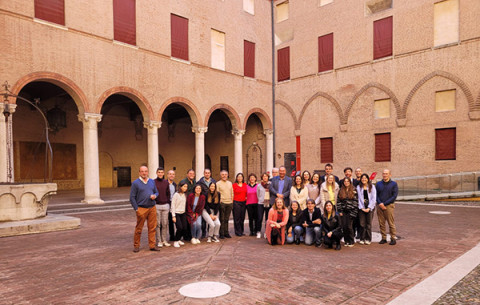Piezo4Spine project holds its annual general meeting in Ferrara, Italy, with "encouraging results"

PIEZO4SPINE, a Pathfinder project coordinated by the Material Science Institute of Madrid (ICMM-CSIC), held its annual general meeting this month at the Italian Institute of Technology at Ferrara, Italy. This is the second in-person meeting to evaluate how the project is working.
Conchi Serrano, ICMM-CSIC researcher and the coordinator of the project, explains that this was "a very productive meeting about the current status of the project's research and the progress made by each of the consortium members".
Some of the outstanding progress are related to the design of nanocarriers for the release of nanomedicines and the design of the first bioprimed 3D matrices doped with nanocarriers. The consortium has also started the first trials in cell cultures with these nanocarriers and matrices, and the results are "encouraging regarding their potential therapeutic use".
"The first preclinical trials have begun in paraplegic rats, establishing motor training and behavioral evaluation protocols that mimic those applied in clinical practice with patients", says Serrano, who celebrates the "perfect coordination between work teams, with effective exchange of samples and results".
The project will have its first evaluation meeting with the European Commission in February, so the researchers are preparing it as well. Serrano attended the meeting at the Castelo Estense alongside other ICMM-CSIC researchers: Mª del Puerto Morales Herrero, Sabino Veintemillas Verdaguer, Ricardo García García, Francisco M. Espinosa Barea, Esther Benayas Martín, Julia Martínez Ramírez and Gloria González Muñiz.
The Piezo4Spine initiative, endowed with 3.6 million euros through the Pathfinder funds of the European Union, is training to to understand spinal cord injury better and, with that knowledge, "provide a therapeutic solution for spinal cord injuries," explains Serrano. "We have considered two specific targets to which the scientific community has not given sufficient importance up to now: Piezo mechanoreceptors and fibroblasts that participate in response to neural damage", says the researcher.
The working hypothesis of the proposal is based on the concept of mechanotransduction, that is to say: "the capacity of our cells and tissues to feel and respond to mechanical stimuli". Serrano indicates that, just as cells are sensitive to chemical and biological stimuli, they feel mechanical movements, and the objective of his work is precisely to investigate these physiological mechanical processes and how they are related to the functioning of neural tissue in a physiological state and pathological.
"Throughout the project, we will develop a three-dimensional matrix by 3D bioprinting loaded with nano vehicles that will deliver active therapies to the lesion site," says Serrano, who is sure that, if successful, "this project will allow access to new knowledge and technologies that could not only be useful for neural regeneration, but also for other pathologies."
Piezo4Spine has the participation of the National Hospital for Paraplegics (Spain), the Italian Technological Institute (Italy), the University of Coimbra (Portugal), the Catholic University of Louvain (Belgium), the company Black Drop Biodrucker GmbH (Germany) and the company ACIB GmbH (Austria).
The project has also prepared this video:
Instituto de Ciencia de Materiales de Madrid (ICMM)
Sor Juana Ines de la Cruz, 3
Cantoblanco, 28049
Madrid, España
Telephone: (+34) 91 334 90 00
Email: @email
Communication Office: @email

Acknowledge the Severo Ochoa Centres of Excellence program through Grant CEX2024-001445-S/ financiado por MICIU/AEI / 10.13039/501100011033

Contacto | Accesibilidad | Aviso legal | Política de Cookies | Protección de datos